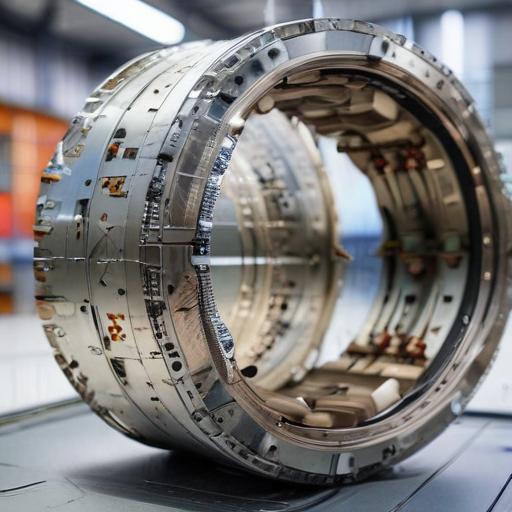OSU helps power upgrade to CERN’s ATLAS detector, a cornerstone experiment at the Large Hadron Collider
A tiny but vital slice of Oklahoma State University sits at the heart of one of physics’ most ambitious machines. Deep underground at the Large Hadron Collider near the Swiss-French border, CERN’s ATLAS detector will receive upgraded components, and OSU researchers are playing a central role in making that upgrade possible.
Precision work drives the project. OSU’s team designs copper traces no thicker than 75 micrometers—about the width of a sheet of paper. The finely tuned traces are part of the inner tracker for ATLAS, specifically the layers closest to the proton collision point. These layers must endure intense radiation while transmitting data with extraordinary speed and accuracy. As one OSU researcher put it, “Space is infinite, but we’re dealing with millimeters,” underscoring the microscopic scale at which the team operates.
For around two decades, faculty and students from OSU’s College of Arts and Sciences have contributed to ATLAS, one of the largest detectors of its kind. The upgrade aims to keep the detector at the cutting edge as the accelerator undergoes maintenance and improvements, with installation slated for 2028. If successful, the enhanced ATLAS detector will continue to help scientists probe fundamental questions about the universe, including the properties of dark matter and the Higgs boson.
The OSU lab responsible for this work was founded about 20 years ago by Dr. Flera Rizatdinova, who remains the head of the physics department. What began as a modest operation has grown into a multidisciplinary research group with three professors, five engineers, and a cohort of graduate and undergraduate students, plus two postdoctoral fellows. The team collaborates across physics, computer science, electrical and computer engineering, mathematics, and materials science, reflecting the complex, cross-disciplinary nature of modern high-energy physics.
“The work here is a melting pot of many disciplines,” says Steven Welch, a senior research engineer who leads the lab. The collaboration brings together students and professionals, all contributing to a shared goal. Dr. Joseph Haley, a professor in the Department of Physics, emphasizes the value of hands-on experience: students working on ATLAS gain practical skills that prepare them for future careers in research and engineering. Haley notes the collaboration mirrors what is seen at top-tier institutions and involves active partnerships with other prestigious groups, expanding opportunities for OSU students.
The project’s scope is daunting. The team develops flexible cables that connect sensors in the detector to the data system, with tolerances measured in micrometers. Three revisions are typical before a component works reliably, underscoring the trial-and-error nature of cutting-edge engineering and the importance of resilience and precision. The stakes are high: once installed, these components must operate flawlessly for about a decade, a span during which maintenance would require dismantling the detector—a monumental undertaking.
ATLAS itself is a global effort. Roughly 5,000 people from around 40 countries contribute to the collaboration, with about 3,500 scientists listed as authors on papers and another 1,500 engineers providing essential support. OSU’s lab has earned a reputation for high-end testing capability, with national laboratories sending equipment to OSU for evaluation and validation. For the students involved, the payoff is tangible: every component bears the builder’s name, a personal connection to the frontier of physics.
Beyond the lab, the project reinforces a broader ethos of collaboration. Rizatdinova highlights the team’s hard work, rapid learning, and the spirit of partnership that enables such sophisticated research. This environment not only advances scientific knowledge but also serves as a powerful training ground for the next generation of researchers and engineers who will tackle future challenges in physics and technology.
A note of optimism frames the story. The upgraded ATLAS detector will give scientists new ways to explore how the universe works at its most fundamental level, potentially revealing new particles and refining our understanding of dark matter and the Higgs field. The OSU team’s success demonstrates how university laboratories can drive large-scale international science while cultivating a skilled, interdisciplinary workforce.
What this means for readers and the scientific community:
– OSU’s interdisciplinary, hands-on approach to large-scale physics projects stands as a model for training students in real-world research responsibly and effectively.
– The upgrade strengthens ATLAS’ capabilities, helping physicists push the boundaries of what we know about matter, energy, and the forces that govern the cosmos.
– The collaboration showcases the importance of university labs in maintaining and advancing global scientific infrastructure and discovery pathways.
Summary of key points
– OSU researchers contribute to the inner tracker components of CERN’s ATLAS detector, focusing on layers closest to the collision point.
– The team develops ultrathin copper traces and flexible cables designed to withstand high radiation and deliver precise data.
– The OSU lab, founded two decades ago, emphasizes interdisciplinary work and hands-on training for students and early-career researchers.
– Upgrades are planned for installation in 2028, with potential implications for discoveries in high-energy physics and our understanding of dark matter and the Higgs boson.
– The project illustrates the collaborative, global nature of modern science and the role of universities in driving major research frontiers.
Additional commentary
– This work not only advances fundamental science but also helps cultivate a generation of engineers and physicists who are versed in both theory and practical fabrication at the smallest scales.
– The emphasis on precision, iteration, and resilience is a valuable lesson for any field that requires high-stakes engineering and reliability.
Overall, OSU’s ongoing partnership with the ATLAS project highlights how university-driven research can contribute meaningfully to world-leading science, train the next generation of scientists, and keep humanity at the forefront of exploring the deepest mysteries of the universe.
